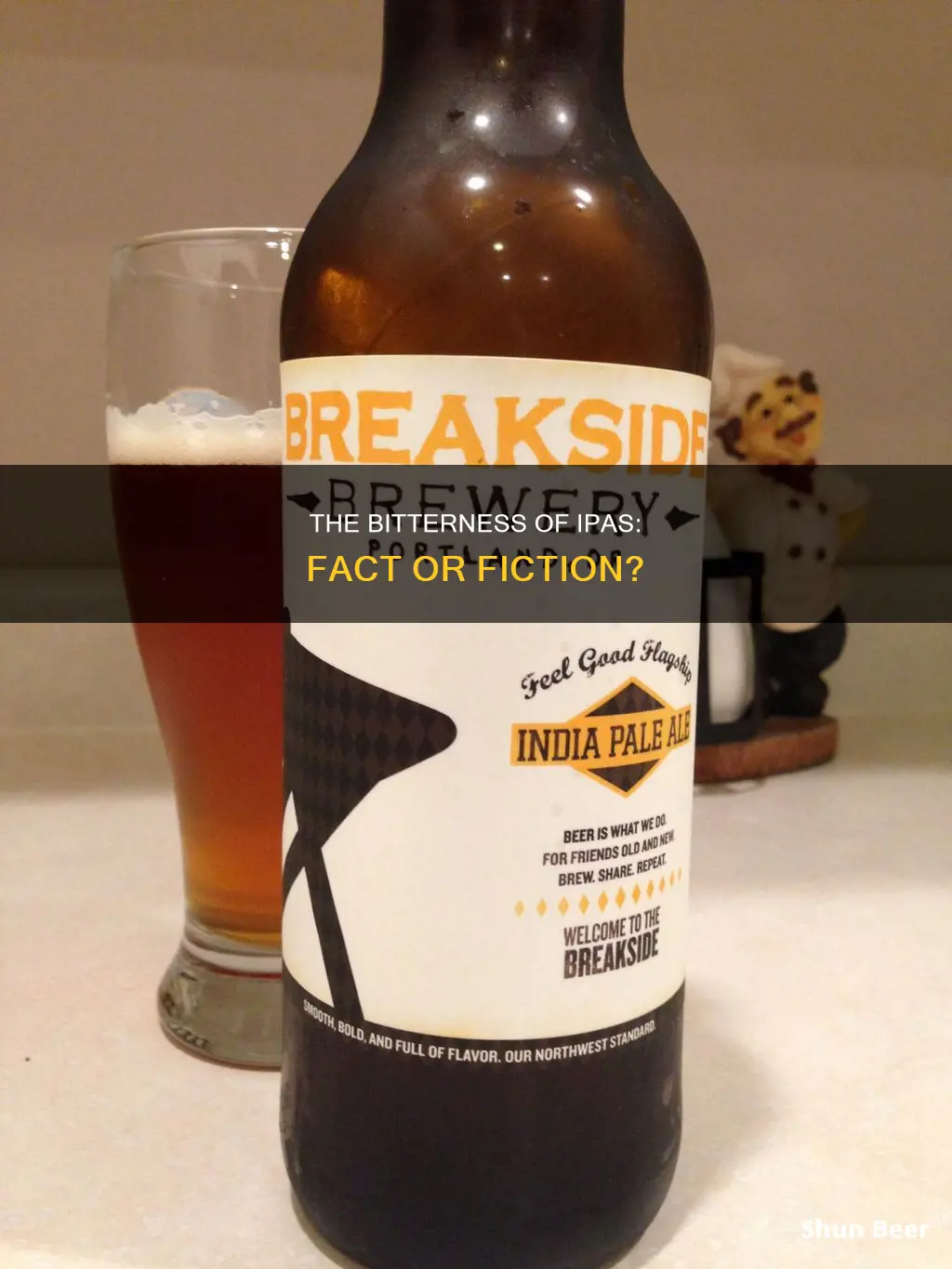
India Pale Ales, or IPAs, are known for their bitterness, but not all IPAs are bitter. The bitterness of an IPA is influenced by factors such as the beer's alcohol content, malt profile, and residual sugars, which can balance out the bitterness. The perception of bitterness also varies from person to person, and it is something that can be acquired over time. While some IPAs are known for their bracing bitterness, others, like the New England-style IPA, have extremely low bitterness and focus more on fruity flavors. The evolution of the IPA style showcases regional variations, with Oregon IPAs, for example, known for their bitterness, while New England IPAs are sought for their sweetness and full mouthfeel.
What You'll Learn
- IPA bitterness is subjective and dependent on individual perception
- Hazy IPAs are often associated with lower bitterness and a fuller mouthfeel
- The bitterness of an IPA can be influenced by factors like alcohol content, malt profile, and residual sugars
- Dry-hopping enhances the aroma of an IPA without contributing additional bitterness
- The American craft beer revolution in the 1980s led to an increase in bitterness in IPAs

IPA bitterness is subjective and dependent on individual perception
The perception of bitterness in IPAs is highly subjective and dependent on individual taste preferences. While bitterness is a prominent characteristic of IPAs, the degree of bitterness perceived can vary from person to person. This is because our taste buds and senses work together to create our unique perception of flavour.
International bitterness units (IBU) are a standard measure of bitterness in beer, but they don't always align with the "perceived bitterness" by drinkers. The alcohol content, malt profile, and residual sugars in a beer can affect how bitter it tastes. For example, an imperial stout with 85 IBUs may not taste bitter due to the balancing sweetness of the beer.
Additionally, our taste preferences can evolve over time. Someone may not enjoy a highly-hopped IPA at first, but their taste buds may adjust, and they may eventually appreciate the bracing bitterness of this style. It's important to note that we are not inherently wired to enjoy bitter flavours. Our aversion to bitterness may be instinctive, as many natural toxins have a bitter taste. However, as we grow up and our palates mature, we may learn to appreciate the complexity that bitterness adds to a beverage.
The evolution of IPA styles also showcases the subjectivity of bitterness perception. The New England IPA, for instance, has extremely low bitterness and focuses on intense, fruity flavours. On the other hand, the West Coast IPA retains some bitterness while exploring fruity notes. The popularity of these styles indicates that drinkers have diverse preferences, with some actively seeking out bitterness while others prefer a more balanced or fruit-forward approach.
In conclusion, the bitterness of IPAs is not a one-size-fits-all experience. Each person's taste is as unique as their fingerprints, and the beauty of the craft beer world lies in its ability to cater to a wide range of flavour preferences.
Craft Beer Enthusiasts: Guinness Blonde Alternatives
You may want to see also

Hazy IPAs are often associated with lower bitterness and a fuller mouthfeel
Hazy IPAs, also known as New England IPAs or Northeast IPAs, are a type of unfiltered and unrefined American India Pale Ale. They are usually heavily dry-hopped and have low bitterness, giving them a juicier, fruitier flavour than traditional IPAs. The haze in hazy IPAs is caused by a high amount of protein and yeast in the beer, which can make it appear cloudy. However, this does not affect the flavour.
Hazy IPAs became popular in the early 2010s when craft breweries in New England began experimenting with new brewing techniques. The style has since become one of the most popular types of craft beer in the United States.
One of the main reasons for the popularity of hazy IPAs is that they are often easier to drink than traditional IPAs, which can be quite bitter. Hazy IPAs tend to be less carbonated, making them smoother and more refreshing. The hops used in hazy IPAs also provide a unique flavour profile that differs from traditional IPAs.
Hazy IPAs are typically brewed with lower levels of carbonation, which gives them a smoother mouthfeel. They also have a distinct sweetness and a fuller, creamier, and smoother mouthfeel compared to regular IPAs. The best hazy IPAs offer a balance of smooth and rich mouthfeel, fruit-forward or juicy flavours, and just enough hoppiness to still be considered an IPA.
While bitterness is a major factor when tasting any IPA due to the increased amount of hops used, the perception of bitterness can vary from person to person. Additionally, the bitterness of an IPA can be affected by other factors such as the beer's alcohol content, malt profile, and residual sugars.
In conclusion, hazy IPAs are often associated with lower bitterness and a fuller mouthfeel. They have become extremely popular due to their unique flavour profiles, smoother mouthfeel, and easier drinkability compared to traditional IPAs.
Guinness Beer: Less Is More, But Why?
You may want to see also

The bitterness of an IPA can be influenced by factors like alcohol content, malt profile, and residual sugars
The bitterness of an IPA, as measured in International Bitterness Units (IBU), is not the only factor that determines how bitter the beer tastes. The "perceived bitterness" of an IPA can be influenced by a variety of factors, including alcohol content, malt profile, and residual sugars.
Alcohol content can affect the perceived bitterness of an IPA. Beers with higher alcohol content may have a more bitter taste, even if the IBU rating is not significantly higher. The interaction between alcohol and bitterness can enhance the overall bitterness of the beer.
The malt profile of an IPA can also impact its bitterness. Different types of malt will contribute to the flavour and mouthfeel of the beer. A maltier beer may have a fuller body and a softer finish, which can balance out the bitterness and make it less pronounced.
Additionally, residual sugars can play a crucial role in the perceived bitterness of an IPA. The presence of residual sugars can add sweetness to the beer, counteracting the bitterness and creating a more well-rounded flavour profile. This balance between bitterness and sweetness is often sought after in IPAs, as it provides a complex and satisfying drinking experience.
It is important to note that the perception of bitterness can vary from person to person, and other factors such as pH and regional preferences may also come into play. However, understanding the role of alcohol content, malt profile, and residual sugars can provide valuable insights into why different IPAs exhibit varying levels of bitterness, even when their IBU ratings are similar.
Brewers can manipulate these factors to create IPAs that cater to different tastes and preferences, showcasing the versatility and complexity of this popular beer style.
Guinness Beer and Coffee: What's the Connection?
You may want to see also

Dry-hopping enhances the aroma of an IPA without contributing additional bitterness
India Pale Ales (IPAs) are known for their bitterness, which comes from the hops used in the brewing process. However, not all IPAs are overly bitter, and some have a more balanced or nuanced flavour profile. Dry-hopping is a technique used in brewing to enhance the aroma and flavour of beer without contributing additional bitterness. This process involves adding hops directly to the fermenting beer, usually during or after primary fermentation.
Hops contain compounds called alpha acids, which provide bitterness to the beer when heated during the boil. This process is called isomerization, and the longer the hops are boiled, the more isomerization occurs, resulting in a more bitter beer. However, when hops are added during fermentation, as in dry-hopping, the aromatic oils in the hops are extracted without the release of bitter alpha acids. This imparts a strong aroma and flavour to the beer without increasing its bitterness.
Dry-hopping is particularly popular in IPAs and American Pale Ales, which are known for their bold hop character. Brewers select hops with high amounts of essential oils and desirable aroma profiles, such as Citra, Mosaic, and Simcoe, which are known for their intense aromas and versatile characteristics. The timing and duration of dry-hopping are carefully controlled to achieve the desired flavour and aroma, with shorter durations resulting in more subtle flavours and longer durations creating more pronounced hop characters.
Double dry-hopping (DDH) is a variation of the dry-hopping technique, where hops are added in two separate stages or in double the quantity. This process is commonly used in New England-style IPAs (NEIPAs) to create a hazy appearance and enhance the complex, fruity, and citrusy flavours and aromas associated with this style. DDH adds an extra layer of hop aroma and flavour, resulting in a sensory delight for those who enjoy hoppy beers.
While IPAs are often associated with bitterness, dry-hopping techniques allow brewers to create well-rounded, nuanced beers with a range of flavour and aroma profiles. By experimenting with different hop varieties, combinations, and techniques, brewers can produce IPAs that appeal to a wide range of taste preferences, showcasing the versatility and complexity of this popular beer style.
Guinness Beer: Meat-Free, But What's the Verdict?
You may want to see also

The American craft beer revolution in the 1980s led to an increase in bitterness in IPAs
The India Pale Ale, or IPA, is the most popular style of craft beer. The signature bitterness of IPAs is derived from hops, which were originally added to pale ales in the 1800s to preserve them during long voyages to India.
The American craft beer revolution began in the 1960s and 1970s, a time when regional breweries were consolidating or closing. The movement gained momentum in the 1980s and 1990s, with the number of craft breweries in the US increasing from 80 in 1983 to over 5,000 in 2016. This growth was driven in part by the increasing popularity of homebrewing and the rise of microbreweries.
During the American craft beer revolution, IPAs became increasingly bitter due to the addition of hops, which provide a signature bitterness and contribute to the overall flavour and aroma of the beer. The increased use of hops in IPAs may be attributed to the growing trend of craft beer enthusiasts seeking more bitter and "advanced" beers. The bitterness of IPAs is often described as evident, bracing, or even aggressive, and has led to a cult-like following among some craft beer drinkers.
While not all IPAs are overly bitter, the style is generally known for its prominent bitter notes. The perception of bitterness can vary among individuals, and tastes can change over time. Some people may acquire a taste for bitter IPAs, similar to how one might develop an appreciation for the bitterness of coffee. Additionally, factors such as serving temperature and freshness can influence the perceived bitterness of an IPA.
Guinness Beer: An IPA or Not?
You may want to see also
Frequently asked questions
No, not all IPAs are bitter. While bitterness is a common characteristic of IPAs, it is not always present, and some IPAs may even have a sweeter taste profile.
IPAs, or India Pale Ales, were originally brewed with a high concentration of hops, which can add bitterness to the beer. Hops were used as a preservative during long voyages, and the resulting bitter taste became associated with the style.
The bitterness of an IPA can be measured using International Bitterness Units (IBUs). However, perceived bitterness can also be influenced by factors such as alcohol content, malt profile, and residual sugars. Therefore, tasting and experimenting with different IPAs is the best way to determine your preference.







